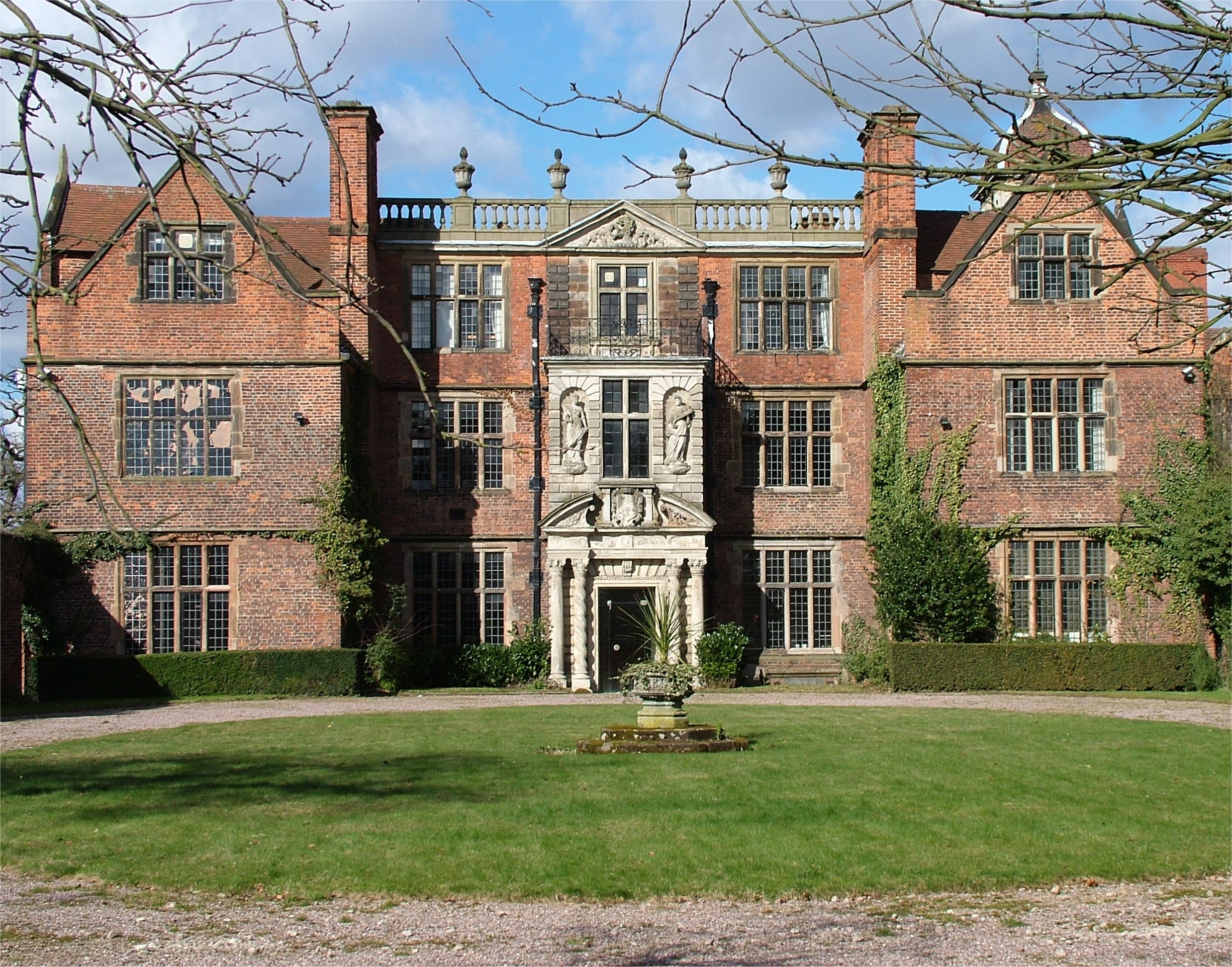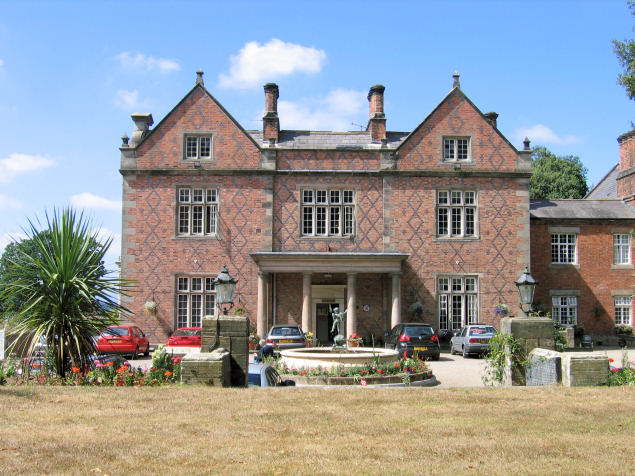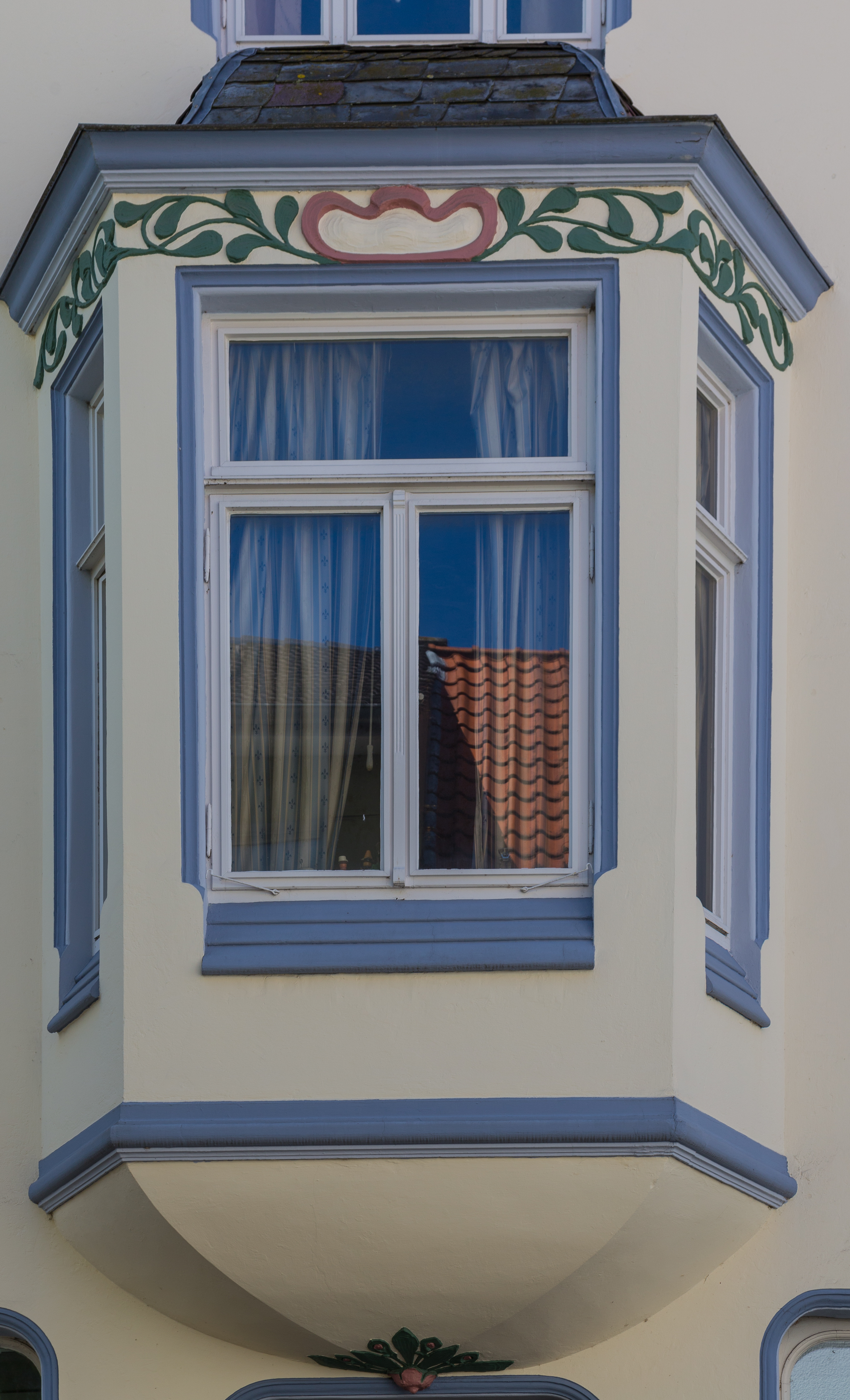|
Willington Hall
Willington Hall is a former country house in the parish of Willington, Cheshire, England. It was extended in 1878, but reduced in size in the 1950s, and has since been in use as a hotel. History The house was built in 1829 by Major William Tomkinson on land purchased in 1827 from Lord Alvanley. Designed by Nantwich architect George Latham, in 1878 a new east front was added for William's son James Tomkinson. At the same time a new wing and stable blocks were added, and in the 1920s a laundry block was built. Although it escaped the fate of the destruction of country houses in 20th-century Britain, during the 1950s it was reduced in size, removing the 1878 east front and some of the outbuildings. In 1955 a portico was added, and it has since been in use as a hotel. The house is recorded in the National Heritage List for England as a designated Grade II listed building. Architecture Willington Hall is constructed in orange brick with buff sandstone dressings and a ... [...More Info...] [...Related Items...] OR: [Wikipedia] [Google] [Baidu] |
Willington, Cheshire
Willington is a village and civil parish from Chester in Cheshire, England. At the 2011 census, the population was 277. The village contains a public house (The Boot), farm shop and hotel (Willington Hall). History The placename means "village of a woman called Winflǣd", from the Old English personal name Winflǣd, and the suffix ''tun'' for farm or village. The name was recorded in the Domesday Book as ''Winfletone'', (under the ownership of Walter de Vernon and consisting of only two households), and then as ''Wynlaton'' in the 12th century. Willington was previously an extra-parochial area in Eddisbury Hundred, which became a civil parish in 1866. From 1894 the civil parish was within Tarvin Rural District, transferring to the Chester district in 1974. Landmarks The Boot Inn occupies a row of red-brick and sandstone cottages that were built in 1815. Behind the pub is Boothsdale, also known as 'Little Switzerland', accessible by a well-used footpath. Willington Hall ... [...More Info...] [...Related Items...] OR: [Wikipedia] [Google] [Baidu] |
Jacobean Architecture
The Jacobean style is the second phase of Renaissance architecture in England, following the Elizabethan style. It is named after King James VI and I, with whose reign (1603–1625 in England) it is associated. At the start of James's reign, there was little stylistic break in architecture, as Elizabethan trends continued their development. However, his death in 1625 came as a decisive change towards more classical architecture, with Italian influence, was in progress, led by Inigo Jones. The style this began is sometimes called Stuart architecture, or English Baroque (though the latter term may be regarded as starting later). Courtiers continued to build large prodigy houses, even though James spent less time on summer progresses around his realm than Elizabeth had. The influence of Flemish and German Northern Mannerism increased, now often executed by recruited craftsmen and artists, rather than obtained from books as in the previous reign. There continued to be very little b ... [...More Info...] [...Related Items...] OR: [Wikipedia] [Google] [Baidu] |
Houses Completed In 1829
A house is a single-unit residential building. It may range in complexity from a rudimentary hut to a complex structure of wood, masonry, concrete or other material, outfitted with plumbing, electrical, and heating, ventilation, and air conditioning systems.Schoenauer, Norbert (2000). ''6,000 Years of Housing'' (rev. ed.) (New York: W.W. Norton & Company). Houses use a range of different roofing systems to keep precipitation such as rain from getting into the dwelling space. Houses generally have doors or locks to secure the dwelling space and protect its inhabitants and contents from burglars or other trespassers. Most conventional modern houses in Western cultures will contain one or more bedrooms and bathrooms, a kitchen or cooking area, and a living room. A house may have a separate dining room, or the eating area may be integrated into the kitchen or another room. Some large houses in North America have a recreation room. In traditional agriculture-oriented societies, domes ... [...More Info...] [...Related Items...] OR: [Wikipedia] [Google] [Baidu] |
Country Houses In Cheshire
A country is a distinct part of the world, such as a state, nation, or other political entity. When referring to a specific polity, the term "country" may refer to a sovereign state, state with limited recognition, constituent country, or dependent territory. Most sovereign states, but not all countries, are members of the United Nations. There is no universal agreement on the number of "countries" in the world, since several states have disputed sovereignty status or limited recognition, and a number of non-sovereign entities are commonly considered countries. The definition and usage of the word "country" are flexible and have changed over time. ''The Economist'' wrote in 2010 that "any attempt to find a clear definition of a country soon runs into a thicket of exceptions and anomalies." Areas much smaller than a political entity may be referred to as a "country", such as the West Country in England, "big sky country" (used in various contexts of the American West), " ... [...More Info...] [...Related Items...] OR: [Wikipedia] [Google] [Baidu] |
Listed Buildings In Willington, Cheshire
Willington is a civil parish in Cheshire West and Chester, England. It contains nine buildings that are recorded in the National Heritage List for England as designated listed buildings. Of these, one is listed at Grade II*, the middle grade, and the others are at Grade II. The parish is entirely rural, and contains two listed country house image:Blenheim - Blenheim Palace - 20210417125239.jpg, 300px, Blenheim Palace - Oxfordshire An English country house is a large house or mansion in the English countryside. Such houses were often owned by individuals who also owned a Townhou ...s, Tirley Garth and Willington Hall, both of which are listed. The other listed structures are associated with these houses, plus a farmhouse. Key Buildings References Citations Sources * * {{DEFAULTSORT:Willington, Cheshire Listed buildings in Cheshire West and Chester Lists of listed buildings in Cheshire ... [...More Info...] [...Related Items...] OR: [Wikipedia] [Google] [Baidu] |
Ashlar
Ashlar () is a cut and dressed rock (geology), stone, worked using a chisel to achieve a specific form, typically rectangular in shape. The term can also refer to a structure built from such stones. Ashlar is the finest stone masonry unit, and is generally rectangular (cuboid). It was described by Vitruvius as ''opus isodomum'' or trapezoidal. Precisely cut "on all faces adjacent to those of other stones", ashlar is capable of requiring only very thin joints between blocks, and the visible face of the stone may be Quarry-faced stone, quarry-faced or feature a variety of treatments: tooled, smoothly polished or rendered with another material for decorative effect. One such decorative treatment consists of small grooves achieved by the application of a metal comb. Generally used only on softer stone ashlar, this decoration is known as "mason's drag". Ashlar is in contrast to rubble masonry, which employs irregularly shaped stones, sometimes minimally worked or selected for simi ... [...More Info...] [...Related Items...] OR: [Wikipedia] [Google] [Baidu] |
Sundial
A sundial is a horology, horological device that tells the time of day (referred to as civil time in modern usage) when direct sunlight shines by the position of the Sun, apparent position of the Sun in the sky. In the narrowest sense of the word, it consists of a flat plate (the ''dial'') and a gnomon, which casts a shadow onto the dial. As the Sun diurnal motion, appears to move through the sky, the shadow aligns with different hour-lines, which are marked on the dial to indicate the time of day. The ''style'' is the time-telling edge of the gnomon, though a single point or ''nodus'' may be used. The gnomon casts a broad shadow; the shadow of the style shows the time. The gnomon may be a rod, wire, or elaborately decorated metal casting. The style must be polar alignment, parallel to the axis of the Earth's rotation for the sundial to be accurate throughout the year. The style's angle from horizontal is equal to the sundial's geographical latitude. The term ''sundial'' can r ... [...More Info...] [...Related Items...] OR: [Wikipedia] [Google] [Baidu] |
Tuscan Order
The Tuscan order (Latin ''Ordo Tuscanicus'' or ''Ordo Tuscanus'', with the meaning of Etruscan order) is one of the two classical orders developed by the Romans, the other being the composite order. It is influenced by the Doric order, but with un- fluted columns and a simpler entablature with no triglyphs or guttae. While relatively simple columns with round capitals had been part of the vernacular architecture of Italy and much of Europe since at least Etruscan architecture, the Romans did not consider this style to be a distinct architectural order (for example, the Roman architect Vitruvius did not include it alongside his descriptions of the Greek Doric, Ionic, and Corinthian orders). Its classification as a separate formal order is first mentioned in Isidore of Seville's 6th-century '' Etymologiae'' and refined during the Italian Renaissance. Sebastiano Serlio described five orders including a "Tuscan order", "the solidest and least ornate", in his fourth book of ... [...More Info...] [...Related Items...] OR: [Wikipedia] [Google] [Baidu] |
Transom (architectural)
In architecture, a transom is a transverse horizontal structural beam or bar, or a crosspiece separating a door from a window above it. This contrasts with a mullion, a vertical structural member. Transom or transom window is also the customary American English, U.S. word used for a transom light, the window over this crosspiece. In British English, Britain, the transom light is usually referred to as a fanlight, often with a semi-circular shape, especially when the window is segmented like the slats of a folding hand fan. A prominent example of this is at the main entrance of 10 Downing Street, the official residence of the Prime Minister of the United Kingdom. History In Gothic architecture, early Gothic Church (building), ecclesiastical work, transoms are found only in belfry (architecture), belfry unglazed windows or spire lights, where they were deemed necessary to strengthen the mullions in the absence of the iron wiktionary:stay, stay bars, which in glazed windows served a ... [...More Info...] [...Related Items...] OR: [Wikipedia] [Google] [Baidu] |
Mullion
A mullion is a vertical element that forms a division between units of a window or screen, or is used decoratively. It is also often used as a division between double doors. When dividing adjacent window units its primary purpose is a rigid support to the glazing of the window. Its secondary purpose is to provide structural support to an arch or lintel above the window opening. Horizontal elements separating the head of a door from a window above are called transoms. History Stone mullions were used in Armenian, Saxon and Islamic architecture prior to the 10th century. They became a common and fashionable architectural feature across Europe in Romanesque architecture, with paired windows divided by a mullion, set beneath a single arch. The same structural form was used for open arcades as well as windows, and is found in galleries and cloisters. In Gothic architecture, windows became larger and arrangements of multiple mullions and openings were used, both for structure and ... [...More Info...] [...Related Items...] OR: [Wikipedia] [Google] [Baidu] |
Gable
A gable is the generally triangular portion of a wall between the edges of intersecting roof pitches. The shape of the gable and how it is detailed depends on the structural system used, which reflects climate, material availability, and aesthetic concerns. The term gable wall or gable end more commonly refers to the entire wall, including the gable and the wall below it. Some types of roof do not have a gable (for example hip roofs do not). One common type of roof with gables, the 'gable roof', is named after its prominent gables. A parapet made of a series of curves (shaped gable, see also Dutch gable) or horizontal steps (crow-stepped gable) may hide the diagonal lines of the roof. Gable ends of more recent buildings are often treated in the same way as the Classic pediment form. But unlike Classical structures, which operate through post and lintel, trabeation, the gable ends of many buildings are actually bearing-wall structures. Gable style is also used in the design of ... [...More Info...] [...Related Items...] OR: [Wikipedia] [Google] [Baidu] |
Bay Window
A bay window is a window space projecting outward from the main walls of a building and forming a bay in a room. A bow window is a form of bay with a curve rather than angular facets; an oriel window is a bay window that does not touch the ground. A window may be all three: projecting outward from the main fascia of a wall, curved in shape, and not reaching the ground. A bay window may be supported from the ground by a foundation, or in space by corbels, brackets, or cantilever. A typical bay window consists of a central windowpane, called a fixed sash, flanked by two or more smaller windows, known as casement or double-hung windows. The arrangement creates a panoramic view of the outside, allows more natural light to enter the room, and provides additional space within the room. Bay windows are often designed to extend beyond the exterior wall, either adding to floor space, often filled with a table, desk, or seating area, or turned into a window seat (often with storage o ... [...More Info...] [...Related Items...] OR: [Wikipedia] [Google] [Baidu] |





